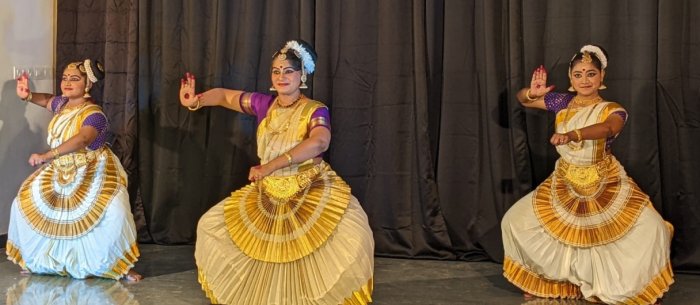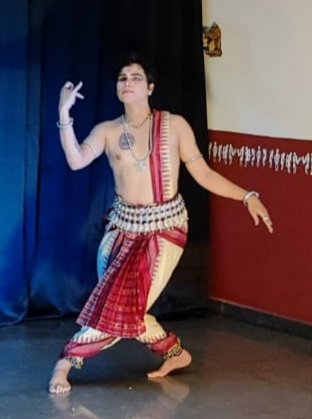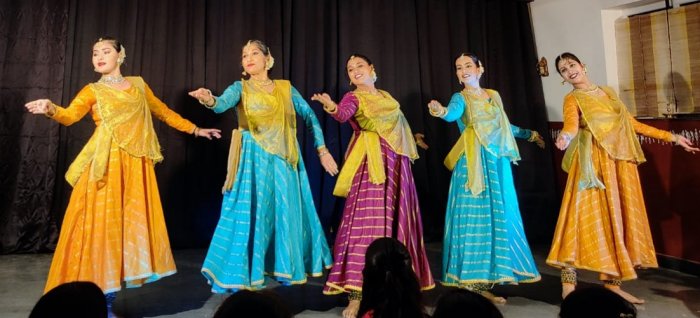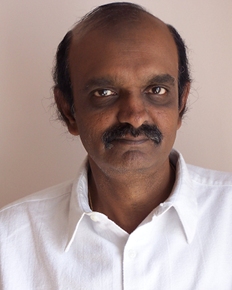
|   |

|   |
Umang - a unique attempt - G Ulaganathan e-mail: ulag_nath@yahoo.com May 13, 2022 The first World Dance Day post Covid saw a number of programmes in Bangalore and dancers and event organisers had a tough time getting an auditorium. Some programmes like Ashish Mohan Khokar's AttenDance launch function was preponed by a day and on April 30th, a few other events were organised at different venues. Among them Umang was a unique event organised by Mohiniyattam dancer and teacher Swapna Rajendrakumar at a small theatre in her rehearsal space in baithak style. This was her maiden attempt and she also made it a paid event charging a nominal amount of Rs.100 which all of us paid gladly. The select gathering of about 100 rasikas were treated to three different style of dance-Mohiniyattam, Odissi and Kathak. Apart from Swapna and her disciples, there was Odissi by Debasish Pattnaik and his students, and Kathak by Sampada Pillai and her disciples.  Swapna Rajendrakumar & disciples The show began with the invocation number Ananda Ganapathy in Ragamalika and adi talam. Music composition was by late M.K. Vasudevan and choreographed byKalamandalam Kshemavathy, who is also Swapna's guru. Swapna and her senior disciples Megna Madhavan and Bhavya Bijoy were the dancers. Then came the brilliant thillana in Bhoopalam raag composed by Balamuralikrishna. The beautiful thillana had Swapna in lovely slow motion and with lively facial expressions. Swapna used the limited space very well and her solo number revealed her mastery over the dance style. Incidentally, she has recently completed her Master's degree in Mohiniyattam from Reva University in Bangalore. The impressive bhajan "Pibare Rama rasam" in raag Ahir Bhairavi was composed by Saint Sadashiva Brahmendra in Sanskrit. "Reciting the Rama nama will help in removing the sorrows of life and fear of death," goes the lyrics. In this bhajan, the dancer shows the episode of Ahalya, wife of sage Gautama. Both lived happily in his ashram spending their days in peace and holy meditation until the lecherous Indira came and ruined it. After Ahalya was turned into a stone, the saint soon realising the mistake, gave her a reprieve -- she would be turned into a woman again when Lord Rama would touch her with his feet. While performing this bhajan, the dancers depicted a variety of moods-and the devotional fervour was maintained throughout this delightful piece.  Debasish Pattnaik The second performer was Debasish Pattnaik and his disciples. In a short time, he has carved a niche for himself in the world of Odissi, has set up a school in Bangalore and is teaching quite a few youngsters. He started with Mangalacharan, salutations to Guru Maheshwara. The original composition was by late Guru Debaprasad Das and imaginatively re-choreographed by Debasish. His disciples Mala Anand, Oindrila Bhattacharjee and Ankita Kapoor presented this item. Next came a Debasish solo, a Pallavi in Kedar Kamodi. In this item composed by Guru Durga Charan Ranbir, the dancer started with soft, tender movements and kept on increasing the pace. With his vast experience dancing on various types of stages in more than 40 countries, Debasish imaginatively made use of the small space and brilliantly used his body and facial bhavas to convey the powerful message that God is supreme and one has to adapt and take the devotional journey towards uniting with him. His masterpiece was the Madhurashtakam, the captivating devotional song composed by Vallabhacharya. Composed in eight stanzas, Madhurashtakam explains the appearance, qualities, symbols, and motifs related to the life of Lord Krishna saying that everything related to Lord Krishna is sweet and he is the Lord of sweetness. The dancer effectively took the audience with him while putting child Krishna to sleep amidst total silence. Debasish's creative talent was obvious as he made subtle changes to the original choreography by his guru.  Sampada Pillai & group The Riddham Kathak school was quite a revelation. Founded by Sampada Pillai who is a disciple of late Guru Dr. Rohini Bhate, Sampada initially trained under Guru Amala Suri Patkar at Kala Academy in Goa where she completed her Parangat diploma in Kathak. She and her disciples Mimansa Verma, Sakshi Taula, Kshama Anagodumath and Girija began with a Shiva -Durga Stuti, the invocation to the supreme deities. This composition was conceptualized and choreographed by Guru Pt. Mohanrao Kallianpurkar of Jaipur gharana. The rhythmic composition was embellished with chosen time cycle. Then they presented the spectacular Tala Dhamaar having a time cycle of 14 beats. This composition of Pt. Birju Maharaj had the stamp of his perfection. The gait, the foot movement and the swaying hip and limbs was a treat to watch. Sampada Pillai and her students stole the show with their speed control, the lovely quick chakkars within the limited space and simple but colourful costumes. Swapna Rajendrakumar is planning to make Umang a regular event and should be able to pull it off as Bangalore has a discerning audience which is willing to pay and go miles to watch a good performance.  G Ulaganathan is a senior dance critic based in Bangalore. |